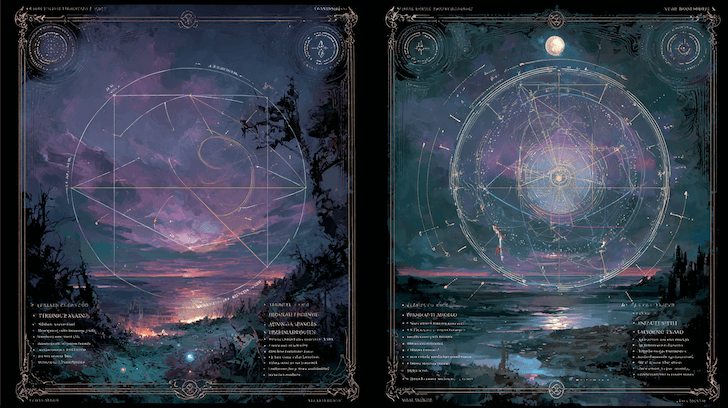What Is a Composite Chart in Astrology?

Most people know about comparing charts through synastry—looking at how one person’s planets interact with another’s. But there’s another level of relationship astrology: the composite chart. Rather than showing how two people affect each other, it shows the relationship itself—as if the connection were its own living entity.
A composite chart combines two natal charts into one by finding the midpoints between matching planetary positions. The result is a new “birth chart” that represents the energy of the relationship itself.
How a Composite Chart Works
To build a composite chart, an astrologer calculates the midpoint between each pair of planets and angles from two natal charts. For example: If your Sun is at 10° Leo and your partner’s is at 10° Aries, the composite Sun lands at 10° Gemini—the exact halfway point.
This midpoint method is applied to:
- All major planets (Sun through Pluto)
- The Ascendant and Midheaven (if accurate birth times are known)
- Lunar nodes and other key points if desired
The composite chart is then read like a normal natal chart—signs, houses, aspects, and configurations all reveal the nature of the relationship as a third being.
What It Represents
A composite chart doesn’t describe either partner individually. It describes the shared energy field between them:
- The tone of the relationship
- What draws them together
- How they handle conflict and growth
- The purpose or “lesson” of the connection
In essence, it’s the “personality” of the relationship itself—its joys, stress points, and reason for being.
- The Sun shows the core purpose of the relationship.
- The Moon shows how the pair feels safe or emotionally at home together.
- The Ascendant reveals how the relationship appears to others.
- The Venus–Mars pattern shows passion, attraction, and creative flow.
- The Saturn aspects reveal stability and long-term responsibility.
- The outer planets show transformation and spiritual development.
Why It’s Useful
Composite charts are especially insightful for:
- Long-term relationships (romantic, business, creative partnerships)
- Families and parent–child dynamics
- Bands, co-founders, or teams with shared goals
They help identify what keeps a partnership balanced, where it gets tested, and what deeper meaning it carries.
A composite chart isn’t about blame—it’s about understanding the third energy you create together, so you can work with it consciously.
Composite vs. Synastry
| Method | Focus | Best For |
|---|---|---|
| Synastry | Compares two charts directly—planet to planet aspects | Understanding attraction, tension, and compatibility between people |
| Composite | Averages the two charts into one shared chart | Understanding the character, life, and purpose of the relationship itself |
Think of synastry as chemistry between two individuals—how energy flows back and forth—while a composite chart is the relationship’s birth chart, showing its trajectory and shared growth pattern.
Reading the Composite Chart
When interpreting a composite chart, pay attention to:
- The Sun and Moon: Core identity and emotional bond of the relationship
- The Ascendant and Midheaven: Public image and shared goals
- Venus–Mars aspects: Love, attraction, and energy balance
- Saturn contacts: Longevity, lessons, and karmic responsibility
- Outer planet placements: Transformation, intuition, and generational influence
- Harmonious aspects (trines, sextiles) show natural flow and comfort.
- Squares and oppositions highlight areas of tension that require effort.
- Conjunctions intensify the energy—whatever the planet pair represents becomes central to the relationship.
Limitations and Timing
Composite charts depend on accurate birth times for both individuals, since house placement and angles shift quickly. If times are uncertain, use a Sun–Moon midpoint composite or a relationship chart by date for general themes.
Some astrologers also track transits and progressions to the composite chart itself, showing when relationships evolve or hit turning points.
A difficult composite chart doesn’t mean failure—it points to lessons and challenges that both partners can consciously work through.
Tips for Working With Composite Charts
- Treat the composite as a shared organism: feed what it needs, not just what you want.
- Compare it with each person’s natal chart to see who feels what more strongly.
- Notice repeated themes—if the composite mirrors both charts’ patterns, the connection runs deep.
- Check transits to the composite chart for relationship milestones and changes.
- Avoid fatalism—composite challenges are invitations to growth, not fixed outcomes.
Conclusion
A composite chart helps you see the soul of a relationship—its chemistry, structure, and destiny. Where synastry shows how you connect, the composite shows what your connection becomes. Together, they provide a fuller picture of how love, partnership, and collaboration evolve over time.
Astrology and Love Life

How to Read a Birth Chart

Get Your Birth Chart
Calculate your complete astrological chart with precise astronomical data based on your birth time and location
Generate Chart